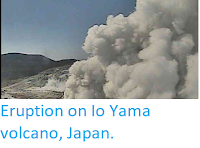The Japan Meteorological Agency
reported volcanic activity on Asamayama, a volcanic complex in central Honshū this month, for the first time since December 2017, with several white plumes observed over the volcano between 16 and 23 July 2018. The volcano has not undergone a major eruption since February 2009, when it produced an ash column 2 km high, through rocks as far as 1 km and caused ash falls as far away as Tokyo. Due to the remote location of Asamayama, even major eruptions seldom cause fatalities, but the volcano is still considered to be dangerous, due to a major eruptive episode in 1783, which covered fields across Honshū with ash, triggering a famine which killed over 20 000 people.
The approximate location of the Asamayama volcano. Google Maps.
Japan has a complex tectonic situation, with parts of the country on
four different tectonic plates. Kyūshū Island lies at the northeast end of the Ryukyu Island Arc, which
sits on top of the boundary between the Eurasian and Philippine Plates.
The Philippine Plate is being subducted beneath the Eurasian Plate, in
the Ryukyo Trench, to the Southeast of the Islands. As it is drawn into
the interior of the Earth, the tectonic plate is partially melted by the
heat of the Earth's interior, and liquid magma rises up through the
overlying Eurasian Plate to form the volcanoes of the Ryukyu Islands and Kyūshū.
The movement of the Pacific and Philippine Plates beneath eastern Honshu. Laurent Jolivet/Institut des Sciences de la Terre d'Orléans/Sciences de la Terre et de l'Environnement.
See also...
Follow Sciency Thoughts on Facebook.














































